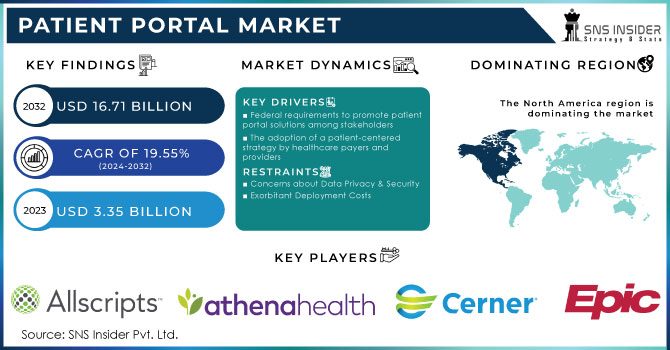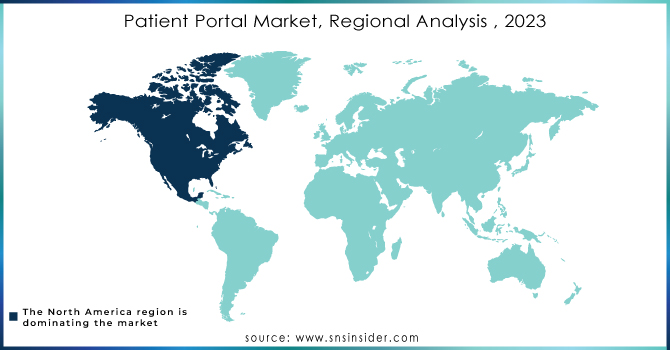Patient Portal Market Report Scope & Overview:

Get more information on Patient Portal Market - Request Sample Report
The Patient Portal Market Size was valued at USD 3.35 billion in 2023 and is expected to reach USD 16.71 billion by 2032 and grow at a CAGR of 19.55% over the forecast period 2024-2032.
Patient Portal Adoption Soars Amid Healthcare Digitalization and Patient-Centric Care Initiatives
The healthcare industry is witnessing a significant surge in the adoption of patient portals, driven by a confluence of factors. This market overview delves into the key drivers, challenges, and growth opportunities associated with patient portal adoption.
Market Overview: Key Drivers and Growth Opportunities
The demand for patient portals is rapidly increasing due to the growing emphasis on patient-centric care and the widespread digitization of healthcare services. As healthcare providers strive to enhance patient engagement and improve care outcomes, patient portals have become essential tools for facilitating communication, accessing electronic health records (EHRs), and scheduling appointments. The rising prevalence of chronic diseases and the aging population are placing additional pressure on healthcare systems, making efficient and accessible care delivery more critical than ever.
The supply of patient portal solutions is robust, with a wide range of vendors offering platforms tailored to different healthcare settings and needs. Software companies are heavily investing in developing innovative features and functionalities to meet the evolving requirements of healthcare providers and patients. Additionally, the integration of patient portals with EHRs and other healthcare technologies is enhancing their capabilities and overall value.
Patient Portal Market Dynamics
Drivers:
-
Surge in EHR and Telehealth Adoption Fuels Patient Portal Market Growth
The patient portal market is experiencing substantial growth, driven by the increasing adoption of EHRs and telehealth services. EHRs have become integral to modern healthcare systems, enabling seamless communication between healthcare providers and patients, thereby enhancing care delivery efficiency. As healthcare systems continue to digitize globally, the demand for patient portals integrated with EHRs is expected to rise, enabling patients to access medical records, communicate with providers, and manage their health more effectively.
The market is also benefiting from a growing emphasis on patient-centric care, empowering patients to take an active role in their health management. Patient portals support this by providing tools for scheduling appointments, requesting prescription refills, and receiving personalized health information, further driving their adoption.
Technological advancements, including artificial intelligence (AI), machine learning, and the Internet of Things (IoT), are enhancing patient portals' functionality, making them more user-friendly and capable of offering predictive insights to improve patient outcomes. These technologies are being integrated into portals to provide advanced features like predictive analytics and AI-driven chatbots for continuous support.
Government initiatives promoting digital health solutions are further fueling market growth. Policies and incentives aimed at widespread EHR and patient portal adoption are creating a more connected and efficient healthcare system.
Restraints:
-
Data Privacy and Security Concerns:
Ensuring the confidentiality and integrity of patient data is a top priority, and breaches can have severe consequences.
-
High Cost of Implementation and Maintenance:
The initial cost of implementing a patient portal, as well as ongoing maintenance expenses, can be a significant barrier for smaller healthcare practices.
-
Interoperability Issues:
Ensuring seamless data exchange between different healthcare systems and patient portals can be complex, hindering the full potential of these solutions.
Patient Portal Market Segmentation
By Type:
The patient portal market is dominated by integrated portals, which accounted for 58.3% of the revenue share in 2023 and are projected to grow at the fastest rate of 19.8% during the forecast period. Integrated portals offer a comprehensive solution that enhances efficiency, provides multiple functionalities, and is cost-effective. They eliminate the need for separate systems and are expected to benefit from ongoing research into pre-integrated EHR peripherals.
Standalone patient portals, while less prevalent, are anticipated to experience significant growth in the coming years. These portals are particularly suitable for smaller healthcare organizations due to their simpler software architecture and lower development costs. They can be developed more quickly and at a more affordable price compared to integrated portals.
By Delivery Mode:
In 2023, web-based patient portals held the largest market share 65.9%, driven by their advantages such as shorter implementation time, no hardware requirements, automatic software updates, and lower initial costs. Unlike on-premises software, web-based software can be accessed remotely and managed by a third party, often through subscription-based pricing models. This offers benefits like affordability, quick return on investment, and easy deployment.
The cloud-based segment is projected to experience a significant growth CAGR of 19.9% due to its ability to facilitate real-time data sharing and integration from various locations and systems. Cloud-based portals offer features like email marketing, online appointment scheduling, health education tools, and social media integration.
By End User:
In 2023, healthcare providers dominated the patient portal market, accounting for 53.0% of the market share and projected to grow at a high rate of 19.7% during the forecast period. According to the Office of the National Coordinator for Health IT (ONC), over 90% of hospitals provide patients with access to their medical records, with 72% allowing users to view, download, and transmit their entire medical records. The widespread adoption of patient portals by healthcare providers is driving the growth of this segment.
The payers segment also holds a significant market share, including government entities like the Centers for Medicare & Medicaid Services (CMS) in the United States and the National Health Service (NHS) in the United Kingdom. These payers process health claims, disburse reimbursements, negotiate provider rates, and collect revenue.
Regional Analysis of the Patient Portal Market
In 2023, North America led the patient portal market with the largest market share 43.8% due to advancements in healthcare IT. The region's success in integrating IT technologies into healthcare systems, coupled with a large population suffering from chronic conditions, is driving market growth. The shift from volume to value-based reimbursement is also increasing the demand for patient portal systems in North America.
Europe is projected to be the second-largest market due to the increased deployment of healthcare IT and telehealth initiatives, as well as the digitization of healthcare procedures. In the Asia-Pacific region, the demand for high-end medical infrastructure is expected to drive market growth, with China, Japan, and India leading the expansion.

Need any customization research on Patient Portal Market - Enquiry Now
Key Players in the Patient Portal Market
Major key players are Allscripts Healthcare Solutions, Inc., Cure MD, Epic Corporation Inc., Athenahealth, eClinicalWorks, Cerner Corporation, McKesson Corporation, NextGen Healthcare Information Systems, LLC, Greenway Health, LLC, Intelichart, GE Healthcare, Med fusion, and other players.
Recent Developments in the Patient Portal Market
-
June 2024: Epic introduced new features to its MyChart patient portal, including enhanced telehealth integration and AI-driven tools for personalized health management. These updates aim to improve patient engagement by offering more intuitive and responsive user experiences, such as predictive appointment scheduling and real-time health monitoring alerts.
-
May 2024: Allscripts rolled out enhancements to its FollowMyHealth patient portal, including advanced security features designed to protect patient data against cyber threats. The new updates also include expanded telehealth capabilities, allowing for more robust virtual care options within the portal, and improved user interfaces to simplify patient navigation and interaction.
-
April 2024: NextGen Healthcare introduced a new suite of analytics tools integrated into its NextGen Patient Portal. These tools provide healthcare providers with deeper insights into patient behavior and outcomes, enabling more personalized and proactive care management. The company also expanded its patient education resources within the portal, helping patients better understand their health conditions and treatment options.
-
March 2024: Athenahealth released new features for its patient portal, AthenaCommunicator, including AI-powered chatbots for 24/7 patient support and enhanced mobile app capabilities. The updates aim to streamline patient-provider communication and improve accessibility, especially for patients in remote or underserved areas. Additionally, Athenahealth has strengthened its data encryption protocols to address growing cybersecurity concerns.
| Report Attributes | Details |
|---|---|
| Market Size in 2023 | US$ 3.35 Billion |
| Market Size by 2032 | US$ 16.71 Billion |
| CAGR | CAGR of 19.55% From 2024 to 2032 |
| Base Year | 2023 |
| Forecast Period | 2024-2032 |
| Historical Data | 2020-2022 |
| Report Scope & Coverage | Market Size, Segments Analysis, Competitive Landscape, Regional Analysis, DROC & SWOT Analysis, Forecast Outlook |
| Key Segments | • By Type (Standalone, Integrated) • By Delivery Mode (Web-Based, Cloud-Based) • By End Users (Providers, Payers, Pharmacies) |
| Regional Analysis/Coverage | North America (US, Canada, Mexico), Europe (Eastern Europe [Poland, Romania, Hungary, Turkey, Rest of Eastern Europe] Western Europe [Germany, France, UK, Italy, Spain, Netherlands, Switzerland, Austria, Rest of Western Europe]), Asia-Pacific (China, India, Japan, South Korea, Vietnam, Singapore, Australia, Rest of Asia-Pacific), Middle East & Africa (Middle East [UAE, Egypt, Saudi Arabia, Qatar, Rest of Middle East], Africa [Nigeria, South Africa, Rest of Africa], Latin America (Brazil, Argentina, Colombia, Rest of Latin America) |
| Company Profiles | Allscripts Healthcare Solutions, Inc., Cure MD, Epic Corporation Inc., Athenahealth, eClinicalWorks, Cerner Corporation, McKesson Corporation, NextGen Healthcare Information Systems, LLC, Greenway Health, LLC, Intelichart, GE Healthcare, Med fusion, and other players. |
| Key Drivers | • Federal requirements to promote patient portal solutions among stakeholders • The adoption of a patient-centered strategy by healthcare payers and providers |
| Restraints | • Concerns about Data Privacy & Security • Exorbitant Deployment Costs • Investments in Infrastructure Are Needed to Support Patient Portals |

